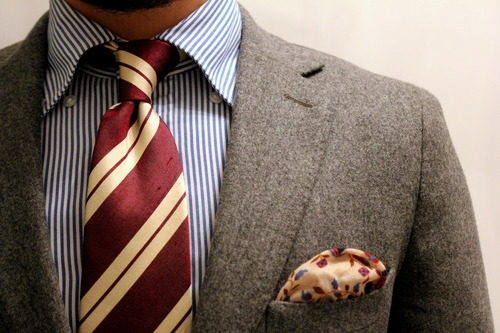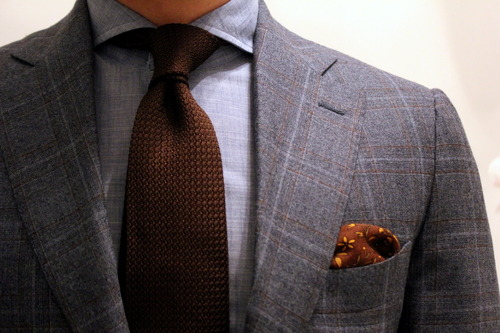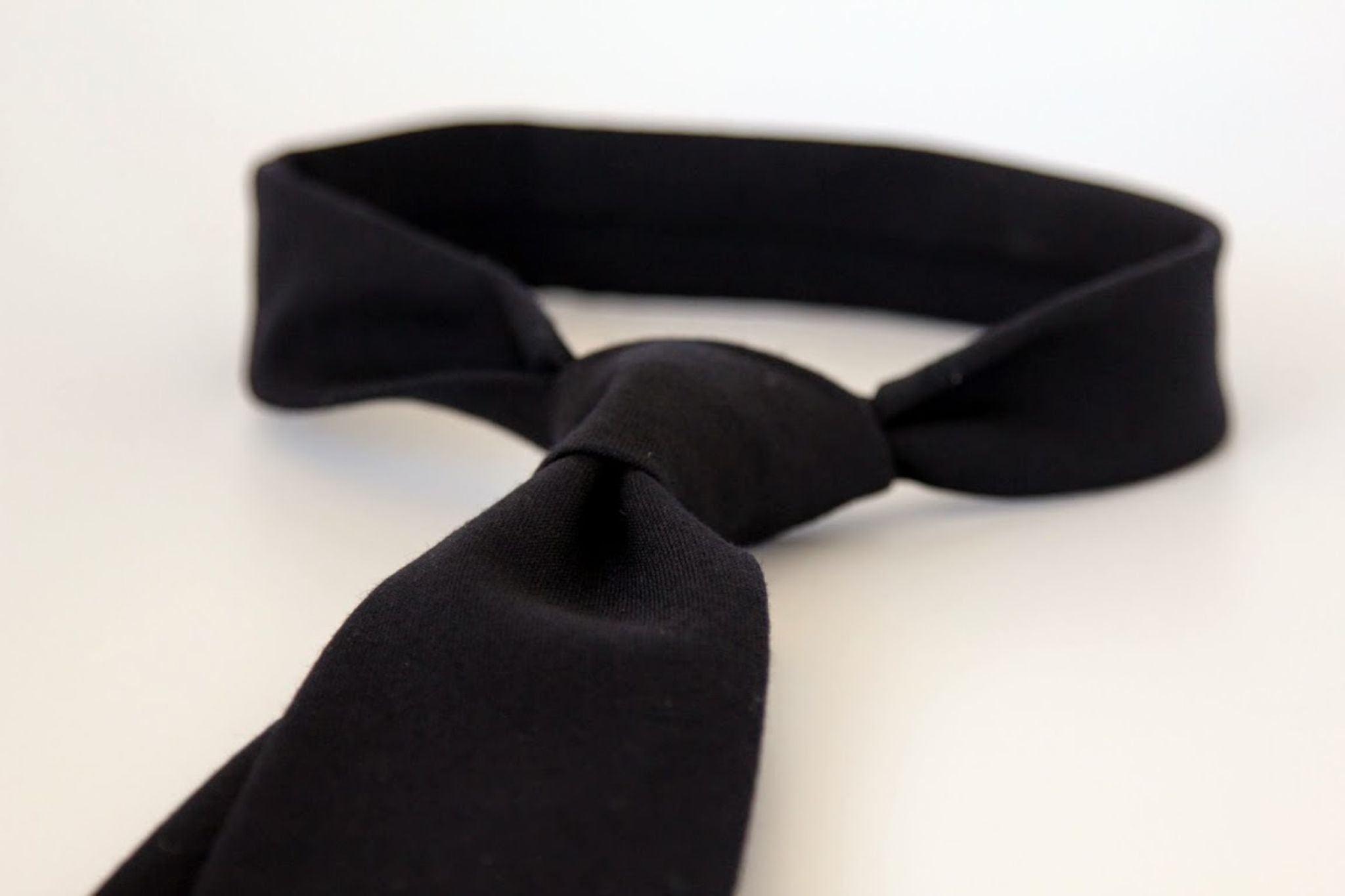How to tie a tie is a topic many guys keep asking and thinking. And actually internet is also full of different guides and even videos about "how to make the right tie knot"?
However those videos and guides usually just gives you technical instructions for different types of tie knots. To know the different types and possibilities is important but even more you should focus on the question how to tie a good looking knot and keep in mind that in the end there's no right or wrong way to tie a tie, but only the ways you like to tie it. This is the answer I usually give whenever someone asks me how I like to tie my tie.
Below I feature three different kind of ties to showcase three different kind of ways to tie a tie and combine it with your total look. 
How to tie a tie? The double four-in-hand knot is my personal favorite.
How to tie a tie – choose the right knot
Four-in-hand, windsor, half-windsor, pratt and double FiH. There are many options to choose from. For me however, there are basically two knots I use regularly; four-in-hand and the double four-in-hand. First one works for most occasions, and the double can be used whenever I feel a bit more “playful”. Double FiH is also a good choice in case you are short as I am. Or if your tie is longer than average and you need to shorten the back blade a bit. Usually if I don’t go with four-in-hand, I choose half-windsor. This most commonly happens with knit-ties.
In case you want to add some character to the way you tie your tie, here’s one way to do that, which comes originally from the Italian style aficionados; after tying the tie, pull it to the side a bit and at same time leave the blade out of the keeper. For a while now it has been in fashion to leave the back blade a bit longer than the front.

The material of your tie is also important when you choose how it makes the best knot.
Half-windsor knot
First in the row is a half-windsor. As mentioned above, this one I prefer to use mostly with knitted ties. This is because many times I feel it might be little tricky to achieve good enough result by using a four-in-hand. Reason to this is that many knitted ties are a bit “lighter” than “normal ties” and therefore the knot can form to be too thin and spare. With half-windsor the knot also keeps it shape better.
To showcase the half-windsor knot I chose a grey knitted cashmere tie crafted from pure Italian cashmere and made by hand in Italy. Here it is featured together with a blazer by Mabro and cashmere cardigan from Uniqlo. Denim shirt is from Massimo Dutti and pocket square by Christian Kimber.
One of the best features of knitted ties is their versatility. Except the most formal occasions they are suitable for business wear as well as they are great “go to”-ties with more casual outfits. And you can easily wear knit ties together with denim and a sport coat. 
Gray cashmere with blue denim and flannel wool.

Gray cashmere tie with half-windsor knot.

Details of gray cashmere knit tie
Four-in-hand
The are many who say that four-in-hand is the only knot you need to know. And I can relate to that. If I needed to pick one to use for the rest of my life - it would be FiH.
Some that are used to do a full-windsor for example might argue that FiH is somehow too small, or that it is crooked and asymmetric. Well, a necktie knot does not need to be symmetric. In fact, it shouldn’t be symmetric. Instead the knot should be expressive and personal.
When at work and wearing a silk tie I usually go with a four-in-hand just as you can see here. The second piece I picked is a wine red striped shantung silk tie, The tie is crafted from shantung silk which is known for its natural slubs that gives texture and a rustic feel to the tie. Even though some might think there is something wrong with the tie as the texture is what it is. But there ain't, it is beautiful. The tie is handmade and untipped, featuring handrolled edges. Here I chose to wear it together with a MTM-flannel suit from Sauma, Kamakura bd-shirt and Berg&Berg wool-silk pocket square. 

Shantung silk tie and four-in.hand knot.

Double four-in-hand
In terms of personal preferences - and as you can see if going through my archives - I favor the double four-in-hand. It’s a bit more “aggressive” than the normal FiH but the reason for me to use is that so I can make the tie to be a bit “shorter”. Many times being 170cm can lead to the fact that the end of the tie is hanging too low. By using a double four-in-hand one can easier alter the lenght. And well, I also like how it looks.
In terms of ties I’ve noticed that more and more I’ve started to use ties that are either monochrome or at least featuring very little and simple pattern (such as the striped one above). Also I have given up almost all of my “basic silk ties” featuring some kind of print. Instead I like to have just a little texture to bring some character to the tie.
The third piece I picked is a dark brown grenadine tie, again untipped and only partially lined. This one has probably become my favorite “wear-in-the-office” tie as the brown color is easy to combine with almost anything and the “large knot grenadine” is also suitable no matter are you wearing a chalk striped suit or a soft wool sport coat and cotton slacks. Here shown together with an MTM-suit by Sauma, chambray-shirt from Isaia and pocket square by Drake’s London. 

Brown grenadine tie and double FiH.

How to choose the right tie
When choosing ties, go for definite colors, small patterns such as little squares or houndstooth, small cashmere prints, lozenges or clear stripes with two or three colors at the most. The colors of a tie should stand out against the jacket and shirt, but not clash with them. It should also be darker than the shirt and more intense than the jacket. With more formal or business clothing, a tie (some cases the pocket square) can be the only place for color, but don’t take this too far; avoid colors like bright yellow, lime green or fire red, but go for a bit more darker colors such dark blue, bottle green, dark brown or cordovan. 

Coordinating your tie with your shirt (and jacket) is a mine-field where only good taste can really guide you. However, you can improve your chances on that mine-field by exploiting some basic tips: avoid pairing a thick patterned tie with a checkered shirt, choosing a tie lighter colored than your shirt or combining a regimental tie with a striped shirt and striped jacket. It’s also been said that you should never have more than 2 or 3 different patterns in your outfit. So in case you are wearing a patterned tie, keep your pocket square and shirt simple. If you’re wearing a shirt with a strong pattern, choose a monochrome tie to go with that.
Never matchy-match your tie and pocket square. Also try to avoid having a too polished and affected comprehensive look but opt for so called “relaxed elegance”.
Sum up - How to tie a tie
Finally some simple advice when tying your tie. Choose your tie to match your outfit (or your outfit to match your tie) and after that is done;- Make sure that there’s never any gap between your tie knot and the collar of your shirt.
- Tighten the knot so that it formes “a triangle” shape from the top to bottom. If you prefer a dimple, go for it. If not, forget it
- After the tie is tied, you should not stop to correct it in every corner but let it be as it is. Constantly keeping an eye on the mirror and correcting your tie will just make you look vain and insecure and can not be considered stylish. This rule applies to other pocket squares and other accessories as well but can many be easier said than done.

Leave a comment